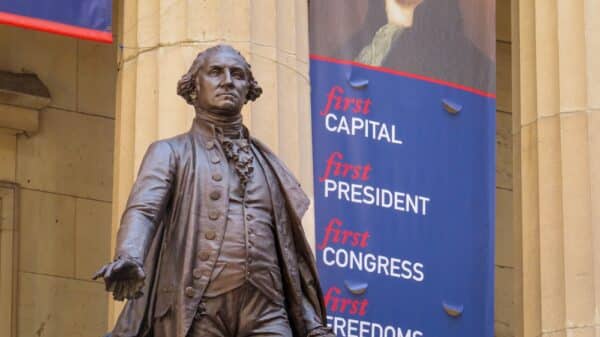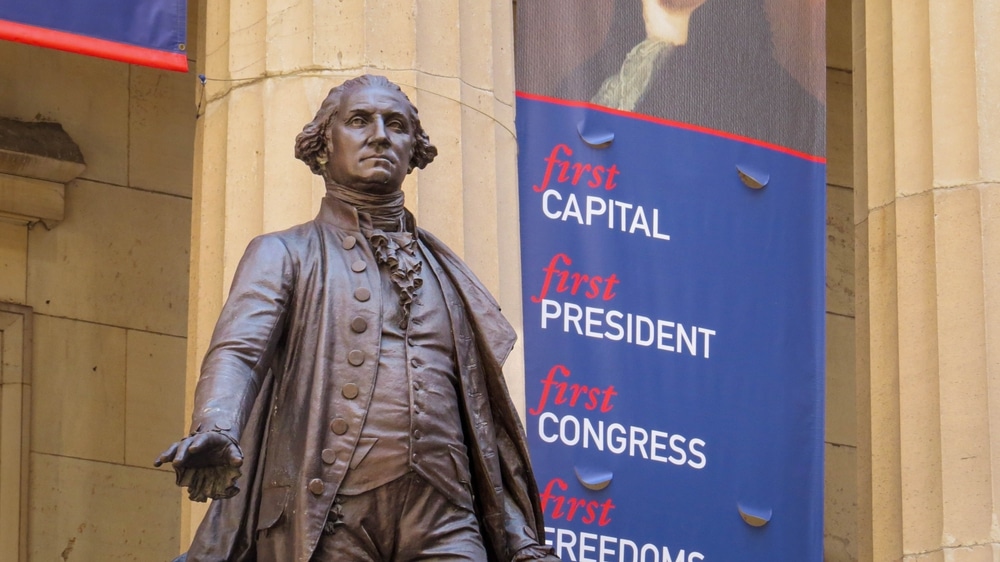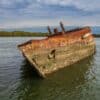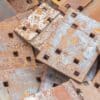George Washington led the Continental Army during the American Revolutionary War (1775–1783). Following his service as President of the United States (1789 to 1797), he briefly oversaw a new army in 1798.
Despite his early age, Washington made a significant impact in the frontier battles against the French and Indians in the 1750s and 1760s. He assumed the principal military role in the American Revolutionary War. When the conflict erupted with the Battles of Lexington and Concord in April 1775, Congress designated him as the first commander-in-chief of the new Continental Army on June 14. The responsibilities he undertook were immense, juggling regional demands, rivalry among his subordinates, morale among the soldiers, Congress’ attempts to micromanage the army’s affairs, requests from state governors for assistance, and a perpetual need for resources to provision, attire, equip, arm, and mobilize the troops. He typically did not have command over the numerous state militia units.
In the initial stages of the war, Washington was frequently in the midst of action, overseeing the siege of Boston to a successful resolution, but subsequently losing New York City and nearly losing New Jersey before clinching surprise victories at Trenton and Princeton towards the end of the 1776 campaign. At the conclusion of 1775 and 1776, he faced the challenge of expiring enlistments since Congress had only sanctioned the army’s existence on an annual basis. With the institution of a more enduring army structure in 1777 and the implementation of three-year enlistments, Washington assembled a dependable cohort of seasoned soldiers, even though securing hard currency and various supplies proved to be arduous. In 1777, Washington encountered another defeat in the protection of Philadelphia but extended crucial aid to Horatio Gates that facilitated the defeat of Burgoyne at Saratoga. Following a demanding winter at Valley Forge and the involvement of France in the war in 1778, Washington shadowed the British forces as they retreated from Philadelphia back to New York and engaged in a ultimately indecisive confrontation at Monmouth Court House in New Jersey.
Washington’s operations from late 1778 to 1780 focused more on diplomatic and organizational aspects as his army maintained a presence outside New York, monitoring Major General Henry Clinton’s forces that held the city. Washington collaborated with the French in devising optimal strategies for joint actions against the British, leading to ultimately unsuccessful efforts to dislodge the British from Newport, Rhode Island, and Savannah, Georgia. His attention was also diverted towards the frontier warfare, prompting the 1779 Continental Army expedition led by John Sullivan into upstate New York. When Major General Clinton dispatched the defector Brigadier General Benedict Arnold to conduct raids in Virginia, Washington commenced detaching portions of his army to counter the escalating threat. Lord Cornwallis’ arrival in Virginia post his campaign in the south presented Washington with an opportunity to deliver a decisive blow. Washington’s troops along with the French forces marched south to confront Cornwallis, and a collaborative French navy under Admiral de Grasse successfully thwarted British endeavors to dominate the Chesapeake Bay, finalizing Cornwallis’ entrapment, who surrendered following the siege of Yorktown in October 1781. Despite Yorktown marking the conclusion of major hostilities in North America, the British still maintained control over New York and other urban centers, necessitating Washington to uphold the army amidst a financially troubled Congress and occasionally rebellious troops dissatisfied with conditions and compensation. The army was officially disbanded after peace was attained in 1783, and Washington relinquished his post as commander-in-chief on December 23, 1783.
Military Background
Born into an affluent Virginia family near Fredericksburg in 1732 [O.S. 1731], Washington received local education until the age of 15. Upon his father’s premature demise when he was 11, opportunities for schooling in England were nullified, and his mother dismissed proposals to have him enlisted in the Royal Navy.[1] Through the marital association of his half-brother Lawrence with the affluent Fairfax family, Washington was designated as the surveyor of Culpeper County in 1749, at a mere 17 years of age. His brother had invested in the Ohio Company, a land procurement and settlement firm aimed at colonizing Virginia’s remote territories, including the Ohio Country, a region north and west of the Ohio River.[2] Investors also encompassed Virginia’s Royal Governor, Robert Dinwiddie, who appointed Washington as a major in the provincial militia in February 1753.[3][4]
Washington played a pivotal part in the eruption of the French and Indian War and subsequently spearheaded Virginia’s defense between 1755 and 1758 as the colonel of the Virginia Regiment. Despite never receiving a commission in the British Army, Washington amassed invaluable military, political, and leadership acumen,[5] garnering significant exposure within the colonies and abroad.[6][7] He closely scrutinized British military strategies, which provided him with a profound understanding of their strengths and vulnerabilities, proving instrumental during the Revolution. He showcased tenacity and valor in the direst circumstances, including setbacks and retreats. He exuded a commanding presence—his stature, robustness, endurance, and gallantry in battle made him appear as a born leader to the soldiers, who followed him unquestioningly.[8][9] Washington honed skills in organization, training, drilling, and disciplining his companies and regiments. Extensive observations, readings, and interactions with professional officers familiarized him with fundamental battlefield tactics and logistical or organizational challenges.[10]
He gleaned insights into overarching strategy, particularly in identifying strategic geographic locations.[11] His experiences imbued him with a skeptical view of militia efficacy, considering them too unreliable, undisciplined, and short-term in comparison to regular troops.[12] However, his command encounters were limited to leading at most 1,000 men, predominantly in remote frontier conditions markedly distinct from the urban settings he confronted during the Revolution in Boston, New York, Trenton, and Philadelphia.[13]
Political Opposition
In December 1758, Washington relinquished his military post, dedicating the ensuing 16 years to managing his affluent Virginia plantation; concurrently, he served within the Virginia House of Burgesses. Despite exhibiting resistance to the 1765 Stamp Act, the initial direct taxation on the colonies, he assumed a less prominent role in escalating colonial resistance until protests against the Townshend Acts (enacted in 1767) gained widespread traction. In May 1769, Washington initiateda proposition, written by his companion George Mason, suggesting that Virginia should cease using British goods until the Acts were revoked.[14] The Townshend Acts were repealed by Parliament in 1770, and, for Washington at least, the dilemma had subsided.
Nonetheless, Washington viewed the enactment of the Intolerable Acts in 1774 as “an infringement on our Rights and Privileges.”[15] In July 1774, he presided over the gathering where the “Fairfax Resolves” were approved, which demanded, among other things, the assembly of a Continental Congress. In August, Washington participated in the First Virginia Convention, where he was chosen as a representative to the First Continental Congress.[16] As tensions escalated in 1774, he aided in the training of county militias in Virginia and oversaw implementation of the boycott of British goods mandated by the Congress.[17][18]
Significant Roles
Combat
General Washington, the Supreme Commander, undertook five primary roles during the conflict.[19][20][21]
- Initially, he devised the overall strategy of the war, in collaboration with Congress. The aim always was independence. Upon France’s entry into the war, he collaborated closely with the soldiers it dispatched—they played a critical role in the significant triumph at Yorktown in 1781.[22]
- Secondly, he led the troops against the principal British forces in 1775–1777 and once again in 1781. While he experienced defeats in many battles, he never surrendered his army throughout the war and persisted in battling the British intensely until the war’s conclusion. Washington diligently worked on establishing an efficient espionage system to uncover British positions and strategies. In 1778, he established the Culper Ring to gather intelligence on enemy movements in New York City. In 1780, it exposed Benedict Arnold’s betrayal. The British intelligence apparatus was completely fooled in 1781, being unaware of Washington and the French armies’ movement from the Northeast to Yorktown, Virginia.[24]
- Thirdly, he was responsible for selecting and guiding the generals. In June 1776, Congress made its initial effort to oversee the war effort through the committee named the “Board of War and Ordnance,” succeeded by the Board of War in July 1777, a committee that eventually included military members.[25][26] The command hierarchy of the armed forces was a patchwork of Congressional appointees (sometimes made without Washington’s consultation) alongside state-appointed officials filling the lower ranks. The outcomes of his general staff varied, as some of his favored individuals never mastered command, like John Sullivan. Eventually, he discovered proficient officers such as Nathanael Greene, Daniel Morgan, Henry Knox (chief of artillery), and Alexander Hamilton (chief of staff). The American officers never matched their adversaries in tactics and maneuvers, often losing most of the direct confrontations. Notable successes at Boston (1776), Saratoga (1777), and Yorktown (1781) were achieved by entrapping the British far from their base with significantly larger troop numbers.[27]
- Fourthly, he assumed responsibility for the army’s training and provision of supplies, ranging from food to gunpowder to shelters. He enlisted regulars and assigned Baron Friedrich Wilhelm von Steuben, a Prussian General Staff veteran, to train them, who effectively transformed Washington’s army into a disciplined and efficient unit.[28] Although the Congress oversaw the war effort and distribution of supplies to the troops, Washington exerted pressure on Congress to provide the essential resources. Despite his efforts, there was consistently a shortage.[29]
- Washington’s fifth and most critical role in the war endeavor was embodying the armed opposition to the Crown, acting as the quintessential figure of the Revolution. His long-term plan was to retain an army in the field continually, and eventually, this approach proved successful. His immense personal and political stature, and his political acumen, aligned Congress, the army, the French, the militias, and the states towards a shared objective. Furthermore, he established the principle of civilian supremacy in military affairs by voluntarily relinquishing his commission and disbanding his army upon victory in the war, rather than proclaiming himself as a monarch. He also aided in dispelling the skepticism surrounding a standing army by emphasizing that well-organized professional troops were twice as effective as poorly trained and led militias.[30]
Information Gathering
George Washington was a proficient overseer of intelligence. He leveraged agents operating behind enemy lines, recruited sources from both Tory and Patriot sides, interrogated travelers for intelligence data, and deployed numerous agents on intelligence and counterintelligence missions. He adeptly conducted deception operations and mastered the art of tradecraft, while also excelling as a propagandist. He maintained sound operational security practices.[31] His significant oversight lapse was failing to detect the signals in 1780 indicating Benedict Arnold’s growing disloyalty and ties to Loyalists.[32]
As an intelligence overseer, Washington insisted on clear and written details outlining an agent’s employment terms and instructions. He stressed the importance of receiving written reports rather than verbal ones. He consistently urged the prompt delivery of intelligence reports, highlighting instances where delayed reports became obsolete. He grasped the necessity of cultivating diverse sources to cross-verify reports and mitigate the risk of losing critical intelligence from a single source due to compromise.[33]
Washington secured a “secret service fund” from the Continental Congress.[34] His preference was for payments in gold or silver. In his financial records, he refrained from disclosing recipient identities: “The names of persons who are employed within the Enemy’s lines or who may fall within their power cannot be inserted.” He directed his generals to spare no expense in intelligence-gathering efforts and emphasized the selection of individuals for intelligence tasks based on their trustworthiness and loyalty.[35]
Boston
Following the Battles of Lexington and Concord near Boston in April 1775, the colonies engaged in warfare. Washington presented himself at the Second Continental Congress in military attire, signaling his readiness for conflict.[36] On June 14, 1775, Congress established the Continental Army and deliberated over its leadership. Washington possessed the prestige, military background, charisma, and commanding presence of a military leader and was renowned as a fervent patriot; he was also well-liked in his home region. There was no serious contender for the role, and Washington made no active effort to pursue the position. Massachusetts delegate John Adams nominated Washington, believing that appointing a southerner to lead an army primarily composed of northerners would foster colonial unity. Washington reluctantly accepted, stating “I do not think myself equal to the Command I [am] honored with.”[37][38]
Washington assumed command of the colonial forces outside Boston on July 3, 1775, amidst the ongoing siege of Boston, after making arrangements in New York City to organize military units for its defense.[39] His initial actions focused on instituting protocols and consolidating militia regiments into an effective fighting unit.[40] Assisting him in this endeavor were his adjutant, Brigadier General Horatio Gates, and Major General CharlesLee, both of whom possessed significant background serving in the British Army.[41]
Upon discovering a critical deficiency of gunpowder in inventory returns, Washington sought new sources. British arsenals were pillaged (including some in the West Indies) and there were attempts at manufacturing; by the end of 1776, a just about sufficient supply (approximately 2.5 million pounds) was secured, mostly from France.[42] In pursuit of heavy armaments, he dispatched Henry Knox on an expedition to Fort Ticonderoga to recover cannons that had been seized there.[43] Resisting repeated entreaties from Congress to initiate assaults against the British in Boston, he convened war councils that supported decisions against such actions.[44] Before the establishment of the Continental Navy in November 1775, Washington, without Congressional approval, commenced arming a “clandestine navy” to prey on poorly guarded British transports and supply ships.[45] When Congress sanctioned an incursion into Quebec, believing that the province’s inhabitants would also revolt against British military dominion, Washington reluctantly assented, even granting Benedict Arnold permission to lead a contingent from Cambridge to Quebec City through the wilderness of present-day Maine.[47]
As the siege lingered, the issue of expiring enlistments grew into a serious worry.[48] Washington endeavored to persuade Congress that enlistments longer than one year were imperative to construct an effective fighting force, but his efforts were rebuffed. The 1776 formation of the Continental Army only stipulated enlistment terms of one year, a matter that would resurface as a problem in late 1776.[49][50]
By positioning Henry Knox’s artillery on Dorchester Heights to overlook the city, and meticulously preparing for an assault on the city from Cambridge if the British attempted to breach the position, Washington ultimately compelled the British to evacuate Boston.[51] The British departed from Boston and set sail, although Washington was unaware that their destination was Halifax, Nova Scotia.[52] Believing they were bound for New York City (which, as it turned out, was indeed Major General William Howe’s ultimate destination), Washington hastily directed the majority of the army in that direction.[53]
New York and New Jersey
Summary
Washington’s triumph in Boston did not find replication in New York. Congress insisted he defend it, recognizing the city’s significance as a naval base and portal to the Hudson River, Washington assigned the task of fortifying New York to Charles Lee in February 1776.[54] The uncertain military campaign in Quebec prompted calls for additional troops there, leading Washington to dispatch six regiments northwards under John Sullivan in April.[55] The larger theaters of war had also introduced regional tensions into the army. Somewhat taken aback that regional disparities would become an issue, on August 1 he delivered a speech to the army, in which he warned of repercussions for “officers or soldiers who, lacking in virtue and love for their country,” might exacerbate the regional differences.[56] The amalgamation of forces from various regions also brought about more widespread camp diseases, especially dysentery and smallpox.[56]
While in New York, Washington grappled with his initial major command dispute, partly rooted in regional discord. New England troops serving in northern New York under General Philip Schuyler, a scion of an ancient patroon family of New York, protested against his aristocratic demeanor, and their Congressional representatives lobbied Washington to replace Schuyler with General Gates. Washington sought to resolve the matter by entrusting Gates with command of the forces in Quebec, however, the failure of the Quebec expedition revived the complaints.[57] In spite of Gates’ experience, Washington personally favored Schuyler. To sidestep a potentially thorny situation, General Washington appointed Schuyler as the overall head of the northern department, but bestowed combat authority on Gates as second in command. This episode divulged Washington to Gates’ aspirations for advancement, possibly at his own expense, and to the latter’s sway in Congress.[58]
Defeat in New York City
General Howe’s army, bolstered by numerous additional troops from Europe and a fleet under the control of his sibling, Admiral Richard Howe, commenced their arrival at the mouth of New York Harbor (at the Narrows) in early July, and executed an unopposed landing on Staten Island.[59] Operating without intelligence regarding Howe’s intentions, Washington was compelled to split his still inadequately trained forces, primarily between Manhattan and Long Island.[60] Despite their political ambivalence towards the conflict, the Howes had been empowered to act as peacemakers, and sought to establish communication with Washington. However, they declined to direct their communications to “General George Washington”, and his representatives refused to accept such correspondence.[61]
In August, the British finally launched their endeavor to capture New York City. Initially, they landed on Long Island in strength, and outflanked Washington’s forward positions in the Battle of Long Island. Major General Howe opted against exploiting a significant tactical advantage that could have resulted in the capture of the remaining Continental troops on Long Island, choosing instead to lay siege to the fortified positions to which they had retreated.[62] While many historians have criticized Washington for sending additional troops to fortify the redoubts on Long Island, it was apparent to both Washington and the Howes that the Americans had effectively obstructed the East River against substantial shipping by scuttling ships in the channel, thereby not risking the entrapment of more men.[63] Confronted with an imminent siege he seemed destined to lose, Washington resolved to retreat. In what some historians consider one of his most remarkable military feats, he executed a nighttime withdrawal from Long Island across the East River to Manhattan to safeguard those troops and supplies.[64]
Subsequently, the Howe brothers paused to strengthen their position, with the admiral engaging in an unproductive peace conference with Congressional envoys on September 11. Four days later, the British landed on Manhattan, with a barrage from the river scattering inexperienced militiamen into a disordered retreat, compelling Washington to fall back even further.[64] After halting the British advance at Harlem Heights on September 16, Howe executed a flanking maneuver, landing troops at Pell’s Point in an attempt to sever Washington’s escape route. To counter this move, Washington withdrew the majority of his army to White Plains, where, following a brief skirmish on October 28, he retreated further north. This action isolated the remaining Continental Army troops in upper Manhattan, prompting Howe to return to the island and seize Fort Washington in mid November, capturing nearly 3,000 prisoners. Four days afterwards, Fort Lee, situated across the Hudson River from Fort Washington, was also captured. Washington transported a significant portion of his army across the Hudson into New Jersey, only to be promptly compelled to retreat by the aggressive British advance.[65]
Throughout the campaign, a general lack of organization, shortages of supplies, fatigue, sickness, and most significantly, a lack of faith in the American leadership resulted in an erosion of untrained regulars and frightened militia. Washington lamented, “The honor of offering a valiant defense does not appear to be enough motivation, when success is highly uncertain, and the prospect of falling into the hands of the enemy is likely.”[66] Washington was fortunate that General Howe wasfocused more on seizing control of New York rather than annihilating Washington’s army.[67] Howe’s rigid adherence to his plans prevented him from seizing the opportunities that emerged during the campaign to decisively act against Washington.[68]
Counteroffensive in New Jersey
Following the loss of New York, Washington’s forces were split. A detachment was stationed north of New York to guard the Hudson River corridor, while Washington led a retreat through New Jersey into Pennsylvania, pursued by Major General Charles Cornwallis.[69] Morale was low, public support wavered, and Congress evacuated Philadelphia out of fear of a British assault.[70] Washington instructed General Gates to bring troops from Fort Ticonderoga and summoned General Lee’s forces, which were positioned to the north of New York City, to join him.[71] Despite a strained relationship with Washington, Lee stalled and only advanced as far as Morristown, New Jersey. On December 12, Lee ventured too far from his army, his exposed position was betrayed by Loyalists, and a British unit under Lieutenant Colonel Banastre Tarleton surrounded the inn where Lee was lodged, capturing him. John Sullivan assumed command of Lee’s troops and successfully marched them to Washington’s camp near Trenton.[72]
The capture of Lee became a crucial point in negotiations regarding the treatment of prisoners. Due to Lee’s prior service in the British Army, he was treated as a deserter and faced potential military penalties for that offense. Despite their strained relationship, Washington threatened to subject captured British officers to the same treatment as Lee and other prominent prisoners. This led to an improvement in Lee’s captivity, ultimately leading to his exchange for Richard Prescott in 1778.[74]
Despite losses from desertions and expiring enlistments, Washington found encouragement in the rise of militia enlistments in New Jersey and Pennsylvania.[75] These militia units actively restrained the British’s ability to scout and forage by encircling their outposts.[76] While Washington did not centrally coordinate this resistance, he effectively leveraged it to orchestrate an assault on a Hessian outpost in Trenton.[77] On the night of December 25–26, 1776, Washington led his forces in a daring crossing of the Delaware River and surprised the Hessian garrison the following morning, capturing 1,000 soldiers.
This maneuver significantly bolstered the army’s spirits but drew Cornwallis out from New York. He regrouped an army of over 6,000 troops and advanced most of them towards a position Washington had secured south of Trenton. Cornwallis deployed a garrison of 1,200 at Princeton and then launched an assault on Washington’s position on January 2, 1777. He was repelled three times before nightfall intervened.[79] Under the cover of darkness, Washington evacuated the position, masking his army’s movements by directing the camp guards to create the illusion of a larger force. Washington then circled around Cornwallis’s position planning an attack on the Princeton garrison.[81]
On January 3, during the American advance, Hugh Mercer encountered British troops under Charles Mawhood from Princeton. In the ensuing engagement, Mercer was fatally injured. Washington dispatched reinforcements under General John Cadwalader who successfully drove Mawhood and the British forces from Princeton, with many escaping to Trenton. The British suffered significant losses, with over a quarter of their force falling in battle, boosting American morale with the victory.[82]
These unanticipated triumphs compelled the British to retreat to the vicinity of New York City, delivering a significant morale boost to the Revolutionary cause.[83] Throughout the winter, while stationed in Morristown for winter quarters, Washington loosely coordinated a guerrilla campaign against British outposts in New Jersey. This involved the collaboration of militia groups from New Jersey and Pennsylvania with strategic use of Continental Army assets to harass the British and German troops encamped in New Jersey.[84]
Washington’s varied performance during the 1776 campaigns managed to stave off significant criticism in Congress.[85] Prior to abandoning Philadelphia for Baltimore in December, Congress granted Washington powers that have since been characterized as “dictatorial.” These triumphs in New Jersey almost elevated Washington to a near-mythical status among some congressmen, fostering a heightened deference towards him within the body.[87] John Adams lamented the “superstitious reverence” Washington was receiving.[85] Washington’s exploits also garnered international attention; Frederick the Great, a renowned military strategist, hailed Washington’s feats at Trenton and Princeton as the most remarkable in the annals of military history. The French foreign minister, a staunch American ally, resumed the provision of French aid.[89]
Philadelphia and Valley Forge
Early Tactical Moves
In May 1777, with uncertainty looming over General Howe’s potential northward advance towards Albany or southward march to Philadelphia, Washington relocated his army to the Middlebrook encampment nestled in New Jersey’s Watchung Mountains. When Howe steered his troops southwest from New Brunswick, Washington correctly interpreted this as an attempt to lure him from his formidable position and stood his ground. Only when Howe seemingly retreated back towards the shore did Washington give chase, successfully thwarting Howe’s bid to dislodge him from his mountainous defenses in the Battle of Short Hills towards the end of June.[90] Subsequently, Howe, already intent on launching a campaign against Philadelphia, departed New Jersey, embarked a substantial portion of his forces on ships in late July, and set sail, leaving Washington puzzled about his intended destination.[91]
Washington’s challenge in deciphering Howe’s intentions stemmed from the presence of a British army progressing south from Quebec towards Fort Ticonderoga under General John Burgoyne’s command. Howe’s exit was partly influenced by Burgoyne’s successful capture of the fort in early July. While Burgoyne had hoped for Howe’s reinforcement in his campaign to gain command of the Hudson, Howe’s lack of support would lead to disastrous repercussions for the British.[93] Upon learning of the fall of Ticonderoga (a stronghold Wayne warned could not be seized without significant loss), Washington was taken aback. Apprehensive that Howe was advancing up the Hudson, he dispatched three of his elite troopsofficers heading north, Benedict Arnold,[95] Benjamin Lincoln, and Daniel Morgan and his group of marksmen. Additionally, he dispatched 750 soldiers from Israel Putnam’s troops to the north to support General Gates in defending the Hudson.[96]
Washington faced challenges with General Arnold in the spring. Congress had implemented a promotion system based on states for the elevation of general officers, leading to the promotion of several officers to major general ahead of others with more experience or seniority. This, combined with the appointment of foreign officers to high ranks, resulted in the resignation of John Stark. Arnold, who had shown his prowess in the Canadian campaign, had expressed intentions to resign.[97][98] Washington advocated on behalf of Arnold and other discontented officers regarding this promotion system, warning Congress that “two or three other very capable officers” might depart because of it. Furthermore, Washington had sown the seeds of discord between Arnold and Gates when he assigned Arnold to command forces in Rhode Island in late 1776. This move led Gates to perceive Arnold as a rival for advancement, causing a deterioration in their previously amicable relationship.[99] Nevertheless, Arnold set aside his grievances upon receiving news of Ticonderoga’s fall and agreed to serve.[95]
Following the urging of their diplomatic representatives in Europe, Congress had also granted military commissions to numerous European mercenaries in early 1777. Among those recommended by Silas Deane, the Marquis de Lafayette and Thomas Conway would play vital roles in Washington’s endeavors.[100][101] Lafayette, only twenty years old, initially found himself told that Deane had overstepped his authority in offering him a major general’s commission, yet he volunteered to serve in the army at his own expense.[102] Upon their first meeting, Washington and Lafayette developed an immediate bond, leading Lafayette to become one of Washington’s most trusted generals and confidants.[103] In contrast, Conway lacked confidence in Washington’s leadership and caused trouble during the 1777 campaign season and its aftermath.[104]
Philadelphia’s Capture
Upon learning of Howe’s fleet moving north in Chesapeake Bay, Washington promptly directed his army south of Philadelphia to defend the city from Howe’s impending threat.[105] During the Battle of Brandywine on September 11, 1777, Major General Howe outflanked Washington and successfully entered Philadelphia on September 26 after additional maneuvers. Washington’s failure to protect the capital resulted in harsh criticism from Congress, which relocated to York, as well as other military officers. In part to quell his detractors, Washington devised an elaborate attack on an exposed British base in Germantown.[106][107] The Battle of Germantown on October 4 was unsuccessful partly due to the intricacy of the assault and the inexperience of the militia forces involved. The capture of over 400 of Washington’s men, including Colonel George Mathews and the entire 9th Virginia Regiment, ensued.[108] The situation was further complicated by Adam Stephen, who led one of the attack branches while intoxicated and deviated from the agreed plan of action.[109] Stephen faced a court martial and was dismissed from the army. Historian Robert Leckie notes that the battle was finely balanced, and slight alterations could have led to a decisive victory for Washington.[110]
Meanwhile, Burgoyne, beyond Howe’s reach for assistance, found himself trapped and compelled to surrender his entire army on October 17, ten days after the Battle of Bemis Heights.[111] This triumph elevated General Gates to hero status, garnering the adulation of Congress.[112] While these events unfolded, Washington oversaw from a distance the loss of control of the Delaware River to the British and subsequently marched his army to winter quarters at Valley Forge in December.[113] Washington selected Valley Forge, contrary to suggestions to camp either closer or farther from Philadelphia, due to its proximity for monitoring British army activities and safeguarding the abundant farmlands to the west from enemy raids.
Image Source: santiagor123 / Shutterstock



































